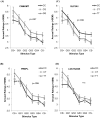Anxiety risk SNPs on chromosome 2 modulate arousal in children in a fear generalization paradigm
- PMID: 31865460
- PMCID: PMC7497385
- DOI: 10.1007/s00787-019-01458-7
Anxiety risk SNPs on chromosome 2 modulate arousal in children in a fear generalization paradigm
Abstract
Alterations in fear learning/generalization are considered to be relevant mechanisms engendering the development of anxiety disorders being the most prevalent mental disorders. Although anxiety disorders almost exclusively have their first onset in childhood and adolescence, etiological research focuses on adult individuals. In this study, we evaluated findings of a recent meta-analysis of genome-wide association studies in adult anxiety disorders with significant associations of four single nucleotide polymorphisms (SNPs) in a large cohort of 347 healthy children (8-12 years) characterized for dimensional anxiety. We investigated the modulation of anxiety parameters by these SNPs in a discriminative fear conditioning and generalization paradigm in the to-date largest sample of children. Results extended findings of the meta-analysis showing a genomic locus on 2p21 to modulate anxious personality traits and arousal ratings. These SNPs might, thus, serve as susceptibility markers for a shared risk across pathological anxiety, presumably mediated by alterations in arousal.
Keywords: Anxiety disorders; Anxiety risk genes; Anxious personality traits; Arousal; Childhood and adolescence; Fear conditioning and generalization.
Conflict of interest statement
On behalf of all authors, the corresponding author states that there is no conflict of interest.
Figures
References
-
- Jacobi F, Höfler M, Siegert J, Mack S, Gerschler A, Scholl L, et al. Twelve-month prevalence, comorbidity and correlates of mental disorders in Germany: the Mental Health Module of the German Health Interview and Examination Survey for Adults (DEGS1-MH) Int J Methods Psychiatr Res. 2014;23(3):304–319. - PMC - PubMed
-
- Beesdo-Baum K, Knappe S, Asselmann E, Zimmermann P, Brückl T, Höfler M, et al. The 'Early developmental stages of psychopathology (EDSP) study': a 20-year review of methods and findings. Soc Psychiatry Psychiatr Epidemiol. 2015;50(6):851–866. - PubMed
-
- Regier DA, Rae DS, Narrow WE, Kaelber CT, Schatzberg AF. Prevalence of anxiety disorders and their comorbidity with mood and addictive disorders. Br J Psychiatry. 1998;173(Suppl 34):24–28. - PubMed
-
- Pine DS. Childhood anxiety disorders. Curr Opin Pediatr. 1997;9:329–338. - PubMed
MeSH terms
Grants and funding
LinkOut - more resources
Full Text Sources
Medical


